Safety Tips for Children in Early Childhood Education from ChildCare Education Institute
Anywhere you go, the safety of our toddlers and preschool children is a topic of concern. We need to become vigilante when it comes to the safety of our kids. A recent study shows more than 794 children were killed by vehicles in 2017. Unfortunately, many of these deaths took place at daycare facilities under the supervision of early childhood educators. Back up cameras are not enough. All adults need to know these safety tips for children from ChildCare Education Institute.
This post contains affiliate links.
According to the CDC, Unintentional injuries—such as those caused by burns, drowning, falls, poisoning and road traffic—are the leading cause of morbidity and mortality among children in the United States. Each year, among those 0 to 19 years of age, more than 12,000 people die from unintentional injuries and more than 9.2 million are treated in emergency departments for nonfatal injuries. Read the CDC report on Childhood Injuries.
Safety Prevention in the Classroom
Safety in the classroom doesn’t just happen, teachers must be prepared and plan for it. What can we do to prevent these senseless deaths and keep our youngest family members safe? When child caregivers and other adults equip themselves with the tools needed to protect children in their care, they can reduce unnecessary injuries and accidents. Safety education is key.
ChildCare Education Institute (CCEI,) the industry leader for online professional development, offers over 55+ safety courses for ECE teachers. These high-quality and research-based courses provide early childhood educators with operating procedures and best practices for keeping children safe on and off school grounds. I highly recommend all ECE professionals explore CCEI’s vast online course catalog and enroll to take their safety courses today!
CCEI has over 35+ certificate programs offered in both English and Spanish! They’ve graduated over 15,000 early childhood professionals from its CDA and other certificate programs -- with over 5 million online course hours completed by students. CCEI’s web-based coursework is available 24/7/365.
Here’s a list of some of the 55+ safety courses offered online with CCEI:
- CCEI112A: Child Abuse: Signs of Abuse and Reporting Requirements for Early Childhood Professionals identifies and defines the major categories of child abuse, explains the responsibilities of mandated reporters, lists methods of reporting, and emphasizes the importance of visual checks.
- HLTH110: Protecting Infants: Reducing the Risk of SIDS and Shaken Baby Syndrome introduces the risk reducing and preventative strategies designed to keep infants safe.
- CCEI110A: Indoor Safety in the Early Childhood Setting introduces early childhood professionals to indoor safety standards in an early childhood setting. Topics covered include toy safety, poison control, the development of appropriate play space, controlling high traffic areas in the center, and other safety standards.
- HLTH104: Basic Health and Hygiene Practices for the Early Childhood Setting provides basic information everyone should know about preventing the spread of infectious diseases in the child care setting.
- CCEI119: Food Allergies in the Early Care Setting provides an overview of food allergies and basic food allergy safety principles to employ in the early care setting.
ChildCare Education Institute offers professionals 150+ online child care training courses (in English and Spanish) to meet licensing, recognition program and Head Start requirements. It’s the perfect online training for busy early childhood teachers. Read our review on CCEI here: Continuing Online Study for Early Childhood Education. I highly recommend you try these safety courses today from CCEI, so you can create a safe environment for your students. The courses are easy to digest and easy to apply to your daily schedules.
Maintaining a healthy and safe environment for children in an early childhood environment is essential. Parents count on caregivers to keep their children safe, healthy, and happy when they're in the classroom. Early childhood professionals need to stay up-to-date on the changes to licensing regulations, best practices, and health and safety standards set forth by governing agencies. Caring for Our Children: National Health and Safety Performance Standards; Guidelines for Early Care and Education Programs has been updated. Learn more about the recent safety standard updates.
Have you considered any of these safety tips for the childcare environment?
- Cots/cribs are placed 3 ft apart or have barrier and assigned to a specific child or cleaned and sanitized after each use
- Furniture and equipment is in good repair (check for broken toys, accessories, wrinkled/disrepair rugs/carpet.)
- All chemicals are locked/out of reach of children.
- All entrances/exits are kept clear of clutter, snow, ice, etc.
- Tables and chairs are not stacked while children are present.
Your state likely has many resources available to help guide the safety practices and policies in your classrooms. Download this free Childcare Health and Safety Checklist PDF from Indiana.gov.
CCEI offers many continuing ed courses for ECE staff and caregivers. I encourage anyone working with children to take courses with CCEI. That’s right, anyone! If you’re a homeschooler, you’ll find many of the courses beneficial to your homeschooling learning environment as well.
ECE teachers in a brick and mortar environment will find that CCEI is convenient and easy to navigate, most classes take about an hour. Preschool teachers and daycare providers alike, will definitely want to take a look at the safety courses and maintain a weekly safety checklist for their program environments.
Looking for fun ideas and activities for preschoolers? Check out our Preschool Scavenger Hunt Group on Pinterest.
Recommended:
More Safety Tips for Kids from Kids Creative Chaos














